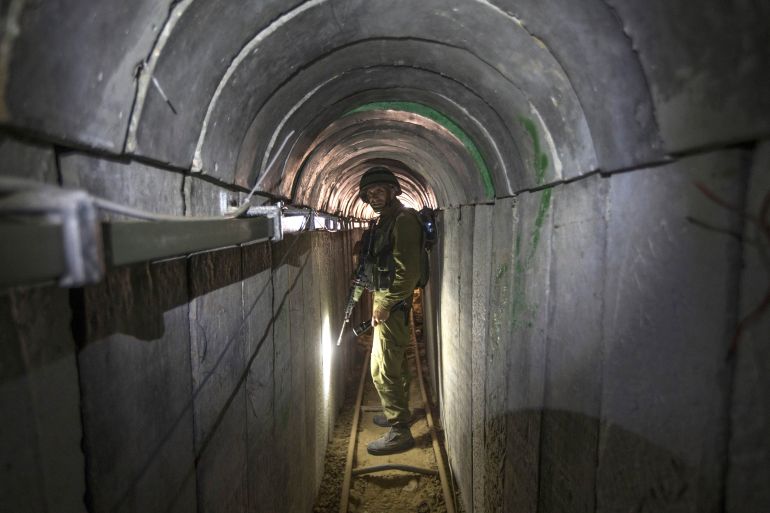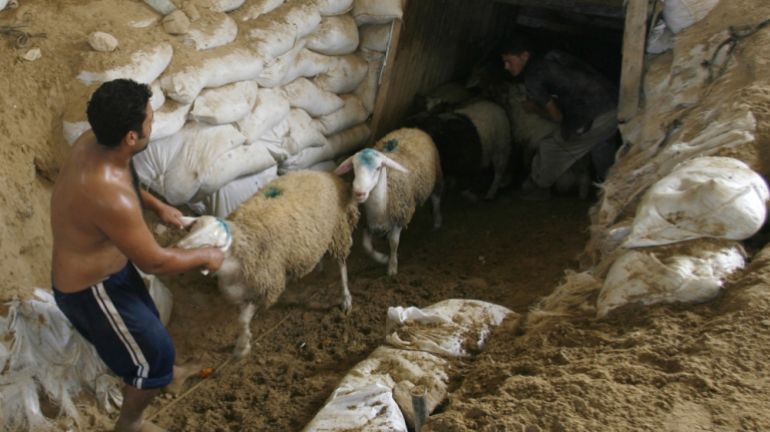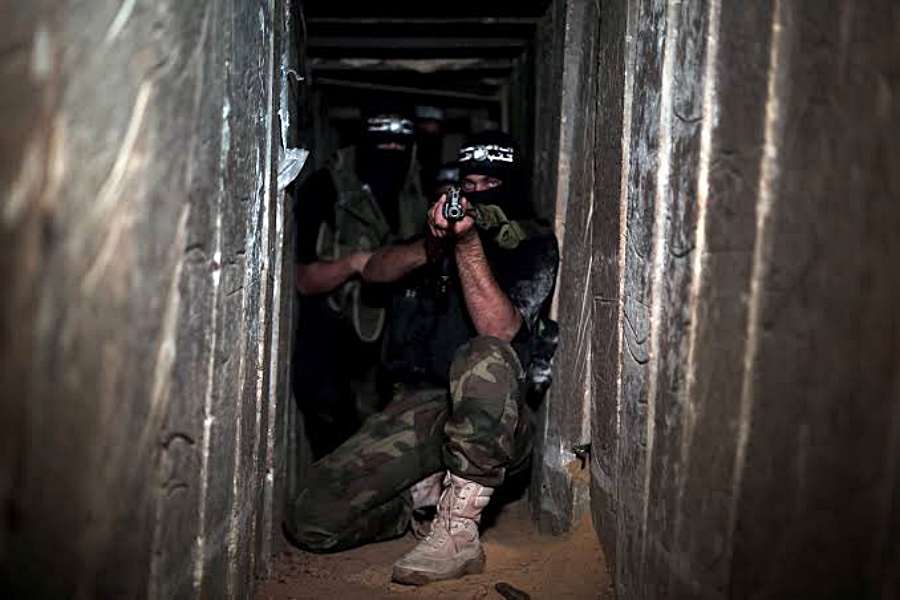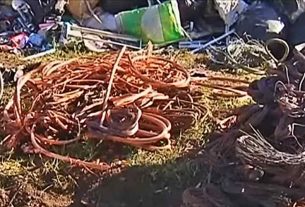Mon 13 October 2023:
As Israeli forces advance forward in northern Gaza, they are also aiming deeper. Their target, a labyrinth of tunnels that the Palestinian armed group Hamas has meticulously crafted throughout the years to build up the core system of its operations.
But while the Israeli military met few obstacles in pounding the besieged strip for more than a month, experts suggest that eliminating the underground spiderweb of tunnels could present its army with far greater challenges.
“It would be a slow, grinding, months-long task to reduce them entirely, and probably the digging will go on as the [Israeli army] tries,” said Richard Outzen, non-resident senior fellow at the Atlantic Council in Turkey and senior fellow at the Jamestown Foundation, a defence policy think tank.
While few know the full extent of what some Israeli officials call the “metro”, the tunnels are believed to cross the entire enclave for hundreds of kilometres, with experts estimating a depth between a range of 15 to 60 metres (50 to 200 feet). In 2021, the Israeli army said that there were 300km (186 miles) of tunnels running under the strip.
Some of these are serviced with oxygen tanks, water pipes and electricity lights. An exclusive video from Al Jazeera Arabic from 2021 shows concrete-reinforced corridors leading to an underground office with a functioning phone line and rooms storing weapons.
The system is believed to have a periphery, with shallower tunnels easier to destroy from the surface, and a core which is where the commando centres, weapons storages, missiles and, more recently, some of the about 240 Israeli captives taken by Hamas, are believed to be. Tunnels allow fighters to conduct surprise attacks and to move quickly across the strip without Israeli eyes being able to trace them.
“One of the main efforts of Hamas for the past 17 years was digging tunnels that would make them resilient, this was not a side activity,” said Andreas Krieg, associate professor at the defence studies department at King’s College London. And what works above ground, does not underneath. “Israel has the technology advantage for everything, but they have been lured into a low-technology war where that competitive advantage is undone the moment they have to go underground,” he added.

An Israeli army officer gives journalists a tour of a tunnel allegedly used by Palestinian fighters for cross-border attacks, at the Israel-Gaza border, July 25, 2014 [File: Jack Guez/AP]
The existing system today is the result of more than two decades of work, starting from the 1980s when tunnels were passages used to smuggle goods from Egypt, said Joel Roskin, a geomorphologist at the Bar-Ilan University in Ramat Gan, Israel, who has long been studying tunnels in Gaza.
Farmers from the area used to dig wells to reach underground water for their fields – a know-how that was then applied to excavate deeper for tunnels. The coastal strip’s soil was easy to carve. “It’s not stone, but sediment made of sand and clay – it goes down metres so it’s easy to dig,” Roskin said.
The first sign that tunnels were being used also by armed groups was in 2001 when an Israeli military post was blown up with an explosive coming from below ground. But it was five years later that the mysterious tunnels breached Israeli public consciousness when Palestinian fighters emerged from a shaft and kidnapped Israeli soldier Gilad Shalit.
After Hamas gained full control of the strip in 2007, winning elections and kicking out rival party Fatah following violent battles, Israel imposed a suffocating blockade. Tunnels turned into the only way to break the siege and get food, goods, weapons, and reportedly, even lions, into Gaza. Their numbers proliferated.
“Hamas started to build up a city below the city knowing that if they would start an armed resistance they would have been able to retaliate and they would have been able to do this underground,” said Krieg.

Palestinian smugglers bring sheep through a smuggling tunnel from Egypt to the Gaza Strip in the Rafah refugee camp, southern Gaza Strip [File: Eyad Baba/AP]
Since October 7, when Hamas fighters broke into southern Israel and killed 1,200 people, the Israeli army has retaliated by bombing Gaza. According to the Palestinian Ministry of Health, Israeli air strikes have killed more than 11,000 people – more than a third of them children. Central to the Israeli military’s argument for targeting civilian and medical infrastructures, where thousands of people are sheltering, is the presence of underground tunnels where it claims Hamas fighters operate. The armed group and medics deny these allegations.
Whether Palestinian fighters have dug tunnels underneath civilian infrastructure or not, human rights groups have accused Israel of not taking adequate precautions to avoid civilian deaths, and of breaching international law.
On the military front, air strikes can’t reach deep enough to destroy the core of the tunnels, say experts. For those, the Israeli army will have to gain control of all exits and entries – an extremely lengthy and dangerous operation. Even if an area has been meticulously cleared, a tunnel shaft could be hidden behind enemy lines, allowing Palestinian fighters to attack Israeli soldiers from the rear.
“It’s a process that requires a lot of time and it’s very risky,” said Krieg. Other options used in the past have included pouring wet cement or sewage, as Egypt did in 2013 along its border, inside tunnels. But these techniques wouldn’t work if the tunnels have multiple entries and exits.

Palestinians search for casualties as they inspect the site of an Israeli strike on a house in Rafah in the southern Gaza Strip [Hatem Khaled/Reuters]
Entering tunnels presents challenges too, and Israel will try to avoid doing so unless strictly necessary, according to analysts. Oxygen is scarce, if not absent. Visibility is limited. And soldiers are vulnerable to ambushes and booby-traps.
Outzen, who is also a former colonel in the United States Army, believes the army will likely use a combined approach.
“Raids into certain tunnels seen as high-value because of hostages or militant leadership, brute force bombing where the tunnels are close to the surface, and demolition operations involving insertion of engineering teams with demolition experts [explosive and mechanical] to collapse central tunnels where possible,” he said.
But such operations demand time which is a resource some believe Israel is fast exhausting. Pressure is mounting on Prime Minister Benjamin Netanyahu’s government to agree to a ceasefire as images of the catastrophic humanitarian situation in Gaza are drawing global condemnation.
Michael Oren, former Israeli ambassador to the US and former deputy minister, said during a conference this week that Israel has a time bomb “ticking rapidly”.
“If the army thinks it has an unending carte blanche to end this operation, I would say no.”
SOURCE: AL JAZEERA
______________________________________________________________
FOLLOW INDEPENDENT PRESS:
WhatsApp CHANNEL
https://whatsapp.com/channel/0029VaAtNxX8fewmiFmN7N22
![]()
TWITTER (CLICK HERE)
https://twitter.com/IpIndependent
FACEBOOK (CLICK HERE)
https://web.facebook.com/ipindependent
Think your friends would be interested? Share this story!





